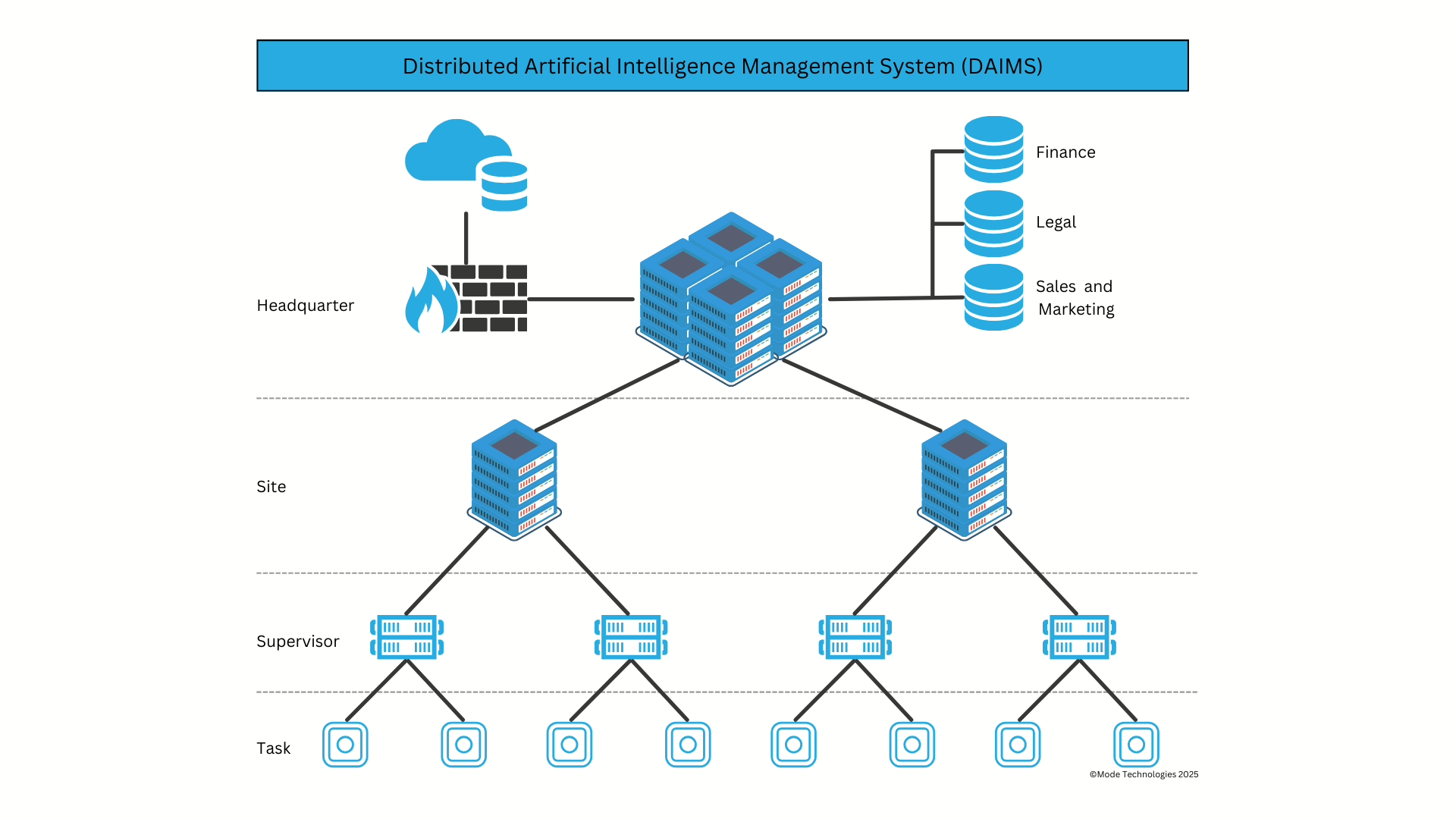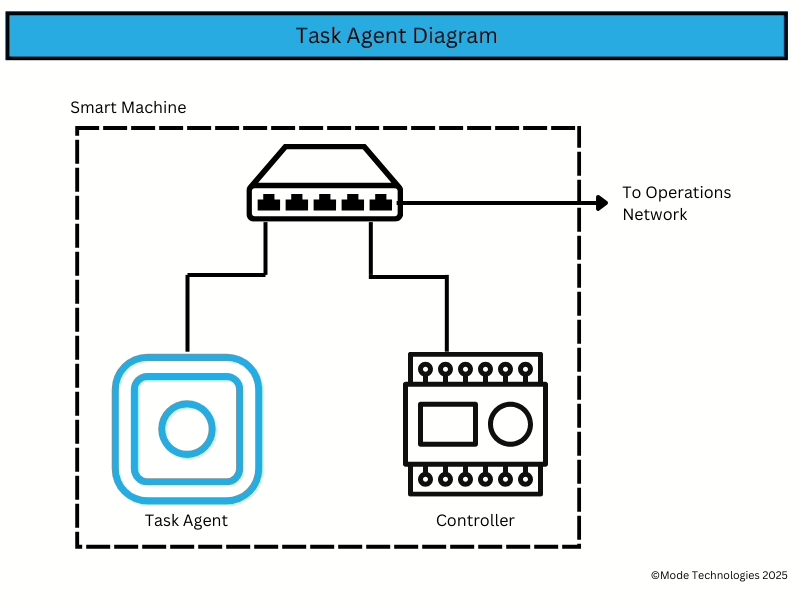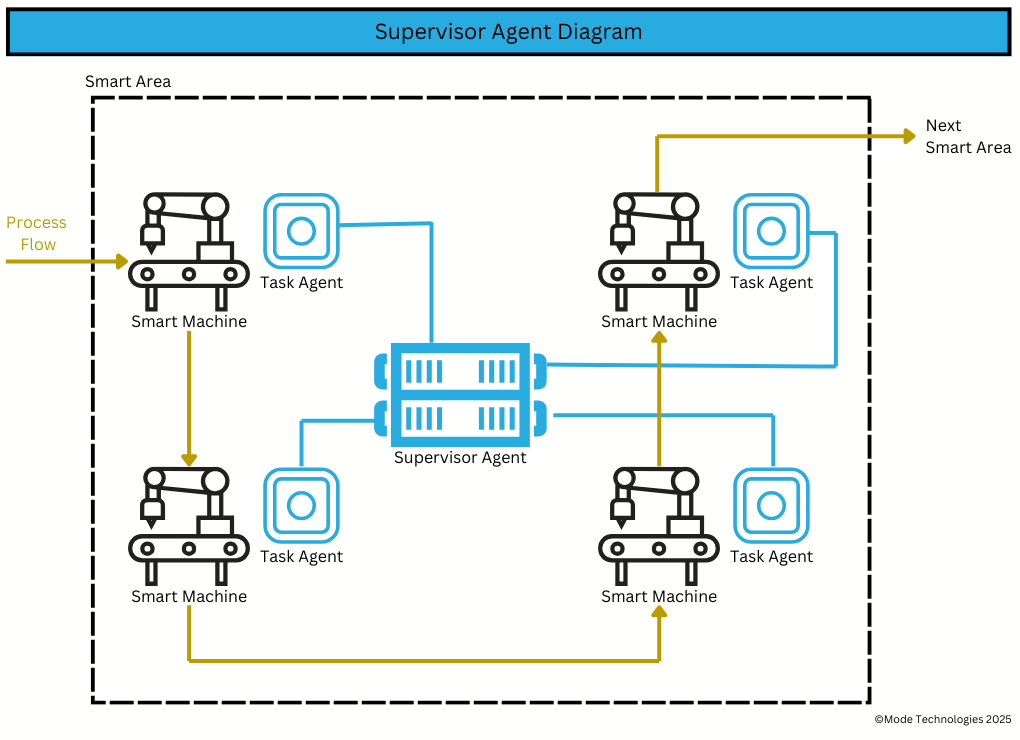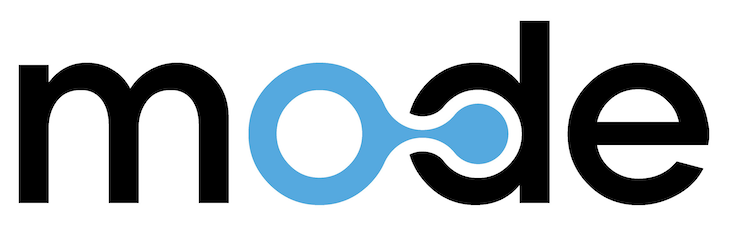Introducing the Distributed Artificial Intelligence Management System (DAIMS): A Bottom-Up Approach to Industrial AI
The Distributed Artificial Intelligence Management System (DAIMS) introduces a new era of industrial intelligence, enhancing existing automation by adding adaptive, goal-oriented AI layers at every level of operation. Instead of relying on centralized processing, DAIMS distributes intelligence across Task Agents, Supervisor Agents, Site Agents, and HQ Agents, ensuring real-time optimization, predictive analytics, and seamless decision-making.
Built for scalability and modular deployment, DAIMS allows organizations to start with a single Task Agent and expand incrementally, validating performance at each stage. By processing data locally through edge computing, DAIMS minimizes network dependencies, enhances security, and aligns automation with real-world business constraints. Each agent plays a distinct role, ensuring that machines, production areas, and entire facilities self-optimize while maintaining operational stability.
This article explores how DAIMS transforms industrial automation, detailing its layered intelligence structure, its ability to rationalize decisions based on business needs, and the strategic advantages of decentralized AI. As industries face increasing complexity and market fluctuations, DAIMS provides a future-proof solution for autonomous, data-driven, and business-aligned industrial operations.

DAIMS vs. Traditional Control Systems: Transforming Industrial Automation from Process Execution to Goal-Driven Optimization
Traditional industrial control systems, such as Programmable Logic Controllers (PLCs) and Distributed Control Systems (DCSs), are highly effective at executing predefined commands with precision and reliability. They excel at following instructions exactly as they are programmed, ensuring that industrial processes function as expected. However, they lack nuance, adaptability, and contextual awareness, which limits their ability to distinguish between what is important and what is not. Control systems such as PLCs are designed to ensure a process runs efficiently, but they operate without considering external factors, business constraints, or overarching objectives. The Distributed Artificial Intelligence Management System (DAIMS) introduces a goal-oriented layer of intelligence that bridges the gap between automated process execution and business-driven optimization, transforming industrial automation from a task-focused system into a strategic decision-making framework.
A fundamental difference between traditional control systems and DAIMS is their respective roles in industrial decision-making. A PLC or DCS controls how something is done, following a sequence of commands to regulate machine operation, process parameters, and automation sequences. In contrast, DAIMS introduces the "why"—a contextual intelligence layer that determines whether an action should be taken based on business needs, financial impact, and operational priorities. This distinction allows DAIMS to optimize processes not only against physical phenomena (such as temperature, pressure, and flow) but also against broader business objectives, such as cost reduction, resource allocation, and production efficiency.
For example, consider a manufacturing facility with a PLC-controlled automated production line. The PLC ensures that raw materials are fed into the system, processed into finished goods, and packaged for shipment. However, if a supplier delay causes a shortage of key components, or a logistics issue prevents immediate shipment, the PLC will continue producing goods at full capacity, unaware that storage costs, excess inventory, and cash flow constraintsmay be negatively impacted. A DAIMS-enabled system, however, would identify these external constraints, rationalize the business implications, and adjust production accordingly. Instead of blindly following the programmed process, the DAIMS system could automatically slow down or temporarily pause production to align with real-world constraints, preventing unnecessary financial losses.
This decision-making capability is enabled by DAIMS’s multi-layered AI architecture, where intelligence is distributed across Task Agents, Supervisor Agents, Site Agents, and HQ Agents. The Task Agent at the machine level would continue operating within its designated parameters, but its Supervisor Agent would recognize broader area-level constraints. The Site Agent would aggregate insights from all processes and detect disruptions in raw material availability, logistics, or supply chain delays. The HQ Agent, integrating financial data and market conditions, could determine that continued full-scale production would result in excess inventory, overutilization of resources, and increased operational costs, prompting a strategic adjustment. This structured intelligence ensures that all actions within an industrial operation align with both real-time process conditions and overarching business strategy.
Another critical distinction between traditional automation and DAIMS is their approach to decision-making. A PLC or DCS is process-oriented, meaning it executes a defined sequence of actions regardless of external conditions. Its role is to ensure that the process runs as specified, with little regard for whether the action makes sense within a larger business framework. DAIMS, on the other hand, is goal-oriented—rather than simply following a set of predefined instructions, it evaluates the impact of each decision based on current constraints, forecasts, and business priorities. This difference enables DAIMS to prioritize actions dynamically, ensuring that decisions are not just technically correct but also strategically beneficial.
Consider a scenario where a chemical processing plant operates 24/7 with high-energy consumption. A traditional control system would regulate the process flow, temperatures, and pressure levels based on fixed operational parameters, ensuring consistent production. However, DAIMS would introduce business intelligence into the system, allowing it to adjust production rates based on energy costs, demand forecasts, and market pricing trends. If electricity costs spike due to peak-hour pricing or if demand for the final product drops, DAIMS could determine that temporarily reducing production or shifting operations to off-peak hours would save significant costs without compromising delivery commitments. This ability to weigh operational actions against financial and market conditions gives DAIMS a strategic edge over traditional control systems, enabling companies to make smarter, real-time decisions that drive profitability.
Another major advantage of DAIMS is its incremental deployment strategy, allowing companies to introduce AI in a controlled manner without disrupting existing automation infrastructure. Traditional AI implementations often require large-scale system overhauls, expensive cloud-based architectures, and extensive data networking to function effectively. DAIMS, by contrast, operates in a decentralized and modular manner, allowing companies to start with a single Task Agent and gradually expand AI integration. Since all AI agents work within the existing control framework, DAIMS does not require wholesale replacement of PLCs or DCSs, but instead adds an intelligent optimization layer on top of them.
DAIMS also fundamentally changes how industrial organizations handle process automation, business constraints, and long-term strategy alignment. By transitioning from rigid, process-driven automation to flexible, goal-driven intelligence, companies can achieve greater efficiency, reduced waste, and improved responsiveness to market fluctuations. The ability to introduce context-aware decision-making into automation systems ensures that businesses do not simply execute processes as they were programmed but rather as they should be executed based on real-world conditions. This transformation positions DAIMS as the next evolution of industrial intelligence, ensuring that automation aligns seamlessly with both operational efficiency and business profitability.
Task Agent: AI at the Machine Level

The Task Agent represents the foundational layer of intelligence within the Distributed Artificial Intelligence Management System (DAIMS), functioning as a dedicated AI entity that enhances individual machines without altering their core control logic. Unlike centralized AI models that rely on cloud computing, the Task Agent is deployed as a specialized Edge AI device, designed to compute complex tasks locally while maintaining machine autonomy and operational integrity.
Each Task Agent is purpose-built for a specific machine or machine type, allowing it to develop a deep understanding of its operational parameters, expected behaviors, and potential failure modes. This localized intelligence enables the agent to self-diagnose issues, analyze alarms with greater contextual depth, and assist in troubleshooting by pinpointing internal problems. The agent operates as if it "is" the machine, making real-time decisions based on direct data inputs from industrial control systems. By continuously monitoring sensor data, actuator responses, and process feedback, the Task Agent not only reacts to existing alarms but also identifies deviations in performance patterns that indicate potential failures. Its ability to triage alarms provides operators with precise diagnostics, reducing unnecessary interventions and improving response efficiency.
Beyond fault detection, the Task Agent is capable of predictive analysis, using historical machine data and real-time sensor readings to anticipate failures before they occur. This enables maintenance teams to shift from reactive repairs to proactive maintenance strategies, reducing unplanned downtime and extending equipment lifespan. Unlike traditional predictive maintenance systems, which often rely on cloud-based processing, the Task Agent performs these calculations entirely on-device, ensuring real-time execution without network dependencies. This localized approach improves reliability, security, and operational speed while maintaining compliance with data-sensitive environments.
A critical function of the Task Agent is its ability to integrate with work order systems, translating its analytical findings into actionable maintenance tasks. Rather than simply flagging an issue, it autonomously generates detailed work ordersthat outline the exact problem, recommended corrective actions, required replacement parts, and relevant maintenance history. If equipped with a 3D model of the machine, the Task Agent can provide spatial awareness, visually guiding maintenance teams to the affected component within the physical environment. These work orders are structured to integrate seamlessly with existing Computerized Maintenance Management Systems (CMMS), ensuring a smooth transition from AI-generated insights to human-executed repairs.
Despite its advanced capabilities, the Task Agent does not replace or modify the base functionality of the machine. It connects to the existing
Supervisor Agent: Intelligence at the Area Level

The Supervisor Agent serves as the coordination and optimization layer within the Distributed Artificial Intelligence Management System (DAIMS), operating at the area level to enhance interactions between individual Task Agents. Installed locally within its designated area, the Supervisor Agent provides a higher-order intelligence that ensures all Task Agents work in alignment with operational goals while resolving discrepancies and optimizing workflows across multiple machines. Unlike Task Agents, which are specialized for individual machines, the Supervisor Agent has a broader scope of awareness, allowing it to refine, direct, and re-prioritize machine-level AI decisions in real time.
This agent plays a critical role in managing complex interactions between multiple machines, ensuring that competing priorities among Task Agents do not lead to inefficiencies or operational conflicts. While Task Agents operate independently to enhance machine intelligence, their perspectives are limited to localized data, which may create competing interpretations of machine conditions and requests. The Supervisor Agent resolves these conflicts, delivering clarifications and guidance based on a wider understanding of the area’s purpose, operational expectations, and overarching efficiency targets. By leveraging advanced predictive modeling, it provides Task Agents with more accurate and forward-looking directives, allowing the system to anticipate problems and optimize processes before inefficiencies arise.
Installed within a local control cabinet or industrial server, the Supervisor Agent is directly connected to each Task Agent through Ethernet-based industrial communication protocols, ensuring low-latency, secure, and reliable data exchange. This physical integration allows the Supervisor Agent to monitor all Task Agent activities in its designated area, making real-time adjustments without reliance on cloud-based systems. With the Supervisor Agent in place, the area transitions into a "smart area", where AI-driven optimization occurs at a system-wide level rather than being limited to individual machines. This enables improved synchronization of machine workflows, reduced operational bottlenecks, and enhanced energy efficiency across the entire area.
Beyond coordination, the Supervisor Agent is also responsible for managing and prioritizing requests generated by Task Agents before they are escalated to higher-level systems. In a traditional setup, individual machines may generate maintenance requests, alarm conditions, or process adjustments without understanding the broader impact of these requests. The Supervisor Agent acts as a filtering and prioritization layer, ensuring that only the most critical and well-structured requests are forwarded to site-level systems, preventing unnecessary disruptions or redundant actions. By incorporating a higher level of awareness and strategic decision-making, the Supervisor Agent prevents reactionary inefficiencies and ensures that the area functions as a cohesive, self-optimizing unit rather than a collection of independently operating machines.
This localized AI-driven supervision provides industries with a structured and scalable approach to implementing artificial intelligence. Instead of introducing AI at a centralized enterprise level, which risks overlooking granular machine-level details, the Supervisor Agent ensures incremental, validated improvements within its designated area. By maintaining direct connections with Task Agents, it enables adaptive optimization, continuous refinement, and real-time decision-making, ultimately transforming traditional industrial areas into intelligent, self-regulating environments that continuously work toward higher efficiency, lower downtime, and improved operational performance.
Site Agent: AI-Driven Optimization at the Facility Level

The Site Agent serves as the central intelligence layer for an entire remote site within the Distributed Artificial Intelligence Management System (DAIMS). Installed within the site’s server room, it functions as the primary AI-driven decision-maker, integrating data from operational systems, financial inputs, and broader enterprise directivesto manage and optimize the facility holistically. Unlike Supervisor Agents, which focus on local area-level optimization, the Site Agent has a macro-level perspective, coordinating all Supervisor Agents to ensure the site operates in alignment with business objectives.
By continuously gathering and analyzing real-time data from Task Agents, Supervisor Agents, site financials, supply chain inputs, and enterprise planning systems, the Site Agent creates a dynamic, data-driven model of site-wide operations. This allows it to identify inefficiencies, predict potential disruptions, and direct resources where they are most needed. One of its core responsibilities is orchestrating interactions between Supervisor Agents, ensuring that localized optimizations do not create bottlenecks or inefficiencies at the site level. The Site Agent works to balance production goals, maintenance schedules, and financial constraints, ensuring that every decision aligns with the overarching HQ Agent directives while maximizing on-site efficiency.
To facilitate real-time decision-making, the Site Agent directly communicates with Supervisor Agents using industrial Ethernet-based protocols or fiber communication, ensuring low-latency and high-bandwidth data exchange. This connectivity enables the Site Agent to deliver instantaneous adjustments to process flows, maintenance schedules, and production targets based on changing site conditions. By maintaining a high-speed, secure communication infrastructure, the Site Agent ensures that Supervisor Agents receive continuous updates and new directives, allowing for adaptive and resilient site-wide operations.
Another critical function of the Site Agent is task reprioritization. As Supervisor Agents generate task requests—whether for maintenance, resource allocation, or operational changes—the Site Agent filters, adjusts, and reorders these requests to align with the most pressing site-wide priorities. This ensures that limited resources are distributed effectively, production schedules remain on track, and maintenance is performed in a way that minimizes impact on uptime and operational efficiency. The Site Agent not only streamlines decision-making within the site but also ensures that enterprise-level goals set by the HQ Agent are fully integrated into day-to-day operations.
The installation of a Site Agent transforms a facility into a "smart site," where real-time AI-driven decision-making enhances productivity, reduces waste, and improves overall resilience. By continuously learning from historical site data, live process inputs, and enterprise-level directives, the Site Agent adapts and evolves, ensuring that the facility remains highly optimized in the face of shifting demands. Through autonomous coordination, predictive insights, and site-wide intelligence, the Site Agent bridges the gap between localized machine control and enterprise-wide strategy, creating a fully integrated AI-driven industrial ecosystem that operates with efficiency, precision, and adaptability.
The Benefits of a Distributed Artificial Intelligence Management System (DAIMS)
The Distributed Artificial Intelligence Management System (DAIMS) is designed to deliver scalable, intelligent automation while minimizing financial and technical barriers to adoption. Unlike centralized AI architectures, which require extensive infrastructure upgrades and high upfront costs, DAIMS follows a modular, bottom-up approach, allowing organizations to gradually integrate AI into their operations without disrupting existing systems. By enabling local computation, incremental scaling, and seamless integration with legacy infrastructure, DAIMS provides a cost-effective and efficient pathway for businesses to achieve AI-driven optimization.
One of the key advantages of DAIMS is its low entry cost, as implementation can begin with a single Task Agent on an individual machine. This allows companies to introduce AI-driven intelligence at a minimal investment, with the ability to expand incrementally as benefits become evident. Organizations are not required to overhaul entire sites or deploy AI across the entire company all at once; instead, they can validate AI performance on a small scale before scaling up. This modular approach enables companies to pilot individual Task Agents, back-test their predictions, and verify outcomes before deploying additional AI layers at the Supervisor, Site, and HQ levels. This structured, phased rollout ensures that each component is proven to be effective before broader implementation, reducing risk and maximizing return on investment.
A critical differentiator of DAIMS is its compatibility with legacy systems. Unlike solutions that require extensive re-engineering of existing automation infrastructure, DAIMS does not replace control systems such as PLCs or DCSs—it simply adds an intelligent layer on top of them. By operating in a non-intrusive manner, the system can monitor, analyze, and optimize processes without modifying core control logic, preserving the stability and reliability of the company's automation framework. This ensures that businesses can adopt AI-driven enhancements without disrupting operations or requiring costly system replacements.
Another major advantage of DAIMS is its reliance on local infrastructure, which significantly reduces the need for large-scale data pipelines between HQ, Sites, and Supervisors. In centralized AI models, where all computation is performed at a corporate data center, vast amounts of machine and process data must be continuously streamed across networks to allow for AI-driven insights. DAIMS eliminates this inefficiency by processing data at the source, with Task Agents, Supervisor Agents, and Site Agents performing computations locally. This reduces the burden on network infrastructure, minimizes latency, and ensures that AI-driven decisions can be executed immediately and reliablywithout dependence on long-distance communication channels.
Additionally, DAIMS is designed to maximize efficiency in infrastructure investments, ensuring purpose-built AI systems that minimize waste and optimize capital expenditures. Since AI deployments are customized for each level of the hierarchy, computing resources are allocated where they are needed most, rather than being concentrated in oversized, underutilized centralized data centers. This approach ensures that companies invest only in the infrastructure required for their specific operational needs, leading to more efficient use of capital and reduced long-term maintenance costs.
Security and access control are also inherently enhanced through DAIMS’s naturally segregated architecture. Because AI computations occur locally at each site, there is no need for constant external data transfers, allowing sites to be independent in terms of network security and access management. This prevents unauthorized cross-site access, ensuring that only site-specific personnel can access their AI-driven insights while maintaining a high level of control over data flow between different parts of the organization.
The DAIMS framework also provides clear visibility into system downtime, ensuring that AI-driven optimizations, updates, and upgrades can be carefully scheduled without unintended disruptions. In centralized architectures, where multiple sites rely on a single processing hub, software updates or infrastructure changes can inadvertently take down entire business segments due to unforeseen dependencies between networked systems. In contrast, DAIMS allows for controlled, localized AI updates, ensuring that system maintenance occurs in a structured, site-specific manner without unexpected cascading failures.
Finally, DAIMS significantly limits exposure to external networks, reducing the risk of cybersecurity threats and data breaches. Because AI computations occur on-site, there is no need to transmit sensitive operational data to external servers or third-party cloud providers, ensuring full control over intellectual property, machine data, and process analytics. This air-gapped approach enhances security while aligning with regulatory and compliance requirements in industries that prioritize data sovereignty and operational confidentiality.
By combining low-cost entry, modular scalability, legacy system compatibility, local processing, infrastructure efficiency, security-enhanced segregation, structured system downtime management, and external network isolation, DAIMS provides a future-proof solution for businesses looking to integrate AI-driven intelligence into their industrial operations without unnecessary risks or excessive capital expenditures. This decentralized AI model allows businesses to retain full control over their data, scale at their own pace, and leverage AI as a strategic advantage rather than a disruptive overhaul.
Conclusion: The Future of Industrial Intelligence with DAIMS
The Distributed Artificial Intelligence Management System (DAIMS) represents a fundamental shift in how industrial automation is managed, transforming operations from rigid process execution to adaptive, goal-driven intelligence. By distributing AI across Task Agents, Supervisor Agents, Site Agents, and HQ Agents, DAIMS enables real-time decision-making, predictive analytics, and seamless optimization at every level of an organization. Its modular design allows companies to incrementally implement AI, ensuring a measured, validated approach that integrates seamlessly with existing systems while minimizing operational risk.
Unlike traditional automation, which follows predefined logic without context, DAIMS rationalizes decisions based on business needs, financial constraints, and real-time operational data. Its edge-computing framework ensures that intelligence remains local, secure, and independent from cloud dependencies, reducing network load and improving response times. This localized processing, combined with structured coordination across AI agents, ensures that every operational decision is aligned with company-wide objectives, optimizing efficiency, reducing waste, and improving overall profitability.
As industries face increasing complexity, market volatility, and operational constraints, DAIMS provides a future-proof framework that allows businesses to scale AI strategically, maintain system resilience, and continuously optimize industrial operations. By bridging the gap between automation and business strategy, DAIMS enables organizations to stay competitive, agile, and intelligent in an era where efficiency and adaptability define success.
At Mode Technologies, we specialize in designing, implementing, and integrating DAIMS tailored to our clients' specific needs. Whether starting with a single Task Agent or building a full-scale AI-driven industrial network, we provide the expertise and technology to ensure a seamless, effective deployment. If you’re looking to enhance automation, reduce inefficiencies, and align your operations with real-world business objectives, we’re ready to build your DAIMS system. Contact us today to learn how intelligent industrial automation can transform your business.
